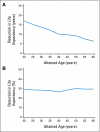Life expectancy in patients surviving more than 5 years after hematopoietic cell transplantation
- PMID: 20065176
- PMCID: PMC2834427
- DOI: 10.1200/JCO.2009.25.6693
Life expectancy in patients surviving more than 5 years after hematopoietic cell transplantation
Abstract
PURPOSE Hematopoietic cell transplantation can cure hematologic malignancies and other diseases, but this treatment can also cause late complications. Previous studies have evaluated the cumulative effects of late complications on survival, but longer-term effects on life expectancy after hematopoietic cell transplantation have not been assessed. PATIENTS AND METHODS We used standard methods to evaluate mortality, projected life expectancy, and causes of death in a cohort of 2,574 patients who survived without recurrence of the original disease for at least 5 years after allogeneic or autologous hematopoietic cell transplantation from 1970 through 2002. Sex- and age-specific comparisons were made with US population data. Results Estimated survival of the cohort at 20 years after transplantation was 80.4% (95% CI, 78.1% to 82.6%). During 22,923 person-years of follow-up, 357 deaths occurred. Mortality rates remained four- to nine-fold higher than the expected population rate for at least 30 years after transplantation, yielding an estimated 30% lower life expectancy compared with that in the general population, regardless of current age. In rank order, the leading causes of excess deaths were second malignancies and recurrent disease, followed by infections, chronic graft-versus-host disease, respiratory diseases, and cardiovascular diseases. CONCLUSION Patients who have survived for at least 5 years after hematopoietic cell transplantation without recurrence of the original disease have a high probability of surviving for an additional 15 years, but life expectancy is not fully restored. Further effort is needed to reduce the burden of disease and treatment-related complications in this population.
Conflict of interest statement
Authors' disclosures of potential conflicts of interest and author contributions are found at the end of this article.
Figures







References
-
- Thomas ED. A history of bone marrow transplantation. In: Appelbaum FR, Forman SJ, Negrin SJ, Blume KG, editors. Thomas' Hematopoietic Cell Transplantation. ed 4. Malden, MA: Blackwell Publishing; 2009. pp. 3–7.
-
- Horowitz MM. Uses and growth of hematopoietic cell transplantation. In: Appelbaum FR, Forman SJ, Negrin SJ, Blume KG, editors. Thomas' Hematopoietic Cell Transplantation. ed 4. Malden, MA: Blackwell Publishing; 2009. pp. 15–21.
-
- Duell T, van Lint MT, Ljungman P, et al. Health and functional status of long-term survivors of bone marrow transplantation. Ann Intern Med. 1997;126:184–192. - PubMed
-
- Socié G, Stone JV, Wingard JR, et al. Long-term survival and late deaths after allogeneic bone marrow transplantation. N Engl J Med. 1999;341:14–21. - PubMed
Publication types
MeSH terms
Grants and funding
LinkOut - more resources
Full Text Sources
Other Literature Sources

